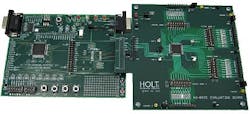32-channel discrete-to-digital sensing circuit for avionics indicators introduced by Holt
MISSION VIEJO, Calif., 10 Feb. 2013. Holt Integrated Circuits in Mission Viejo, Calif., is introducing the HI-8435 3.3-volt, 32-channel, discrete-to-digital sensing integrated circuit (IC) for aviation sensor applications, such as "hatch open" and "wheels up" indicators.
The IC with SPI interface and built-in lightning protection has its sense input thresholds and hysteresis programmable via the 20 MHz SPI bus and all 32 sense output states may be read with one SPI command.
The 32 sensing channels are divided into four banks of eight inputs, with each bank configurable over the SPI bus to detect either Ground/Open or 28-volt/Open signals. The device complies with Airbus ABD0100H.
Thresholds and hysteresis are programmable in 0.5-volt steps from 2-volt to 21-volt, with Ground/Open and 28-volt/Open input banks independently configurable.
Users may implement a 32-channel solution using one device or increase the number of channels by controlling a number of devices on one SPI bus using individual chip-selects.
The device is available in an industrial-temperature version that operates in -40 to 85 degrees Celsius, as well as in an extended-temperature version that operates in the full military operating range of -55 to 125 C.
Several standard package options, including 44 pin PQFP and compact 7-by-7-millimeter 44-pin QFN, are available. For more information contact Holt online at www.holtic.com.
Related stories
Single-IC rugged MIL-STD-1553 databus interface terminals for extended temperatures introduced by Holt
Single-IC rugged MIL-STD-1553 databus interface terminals for extended temperatures introduced by Holt
Single-chip 3.3-volt IC for ARINC 717 flight data recorder avionics databus introduced by Holt.

